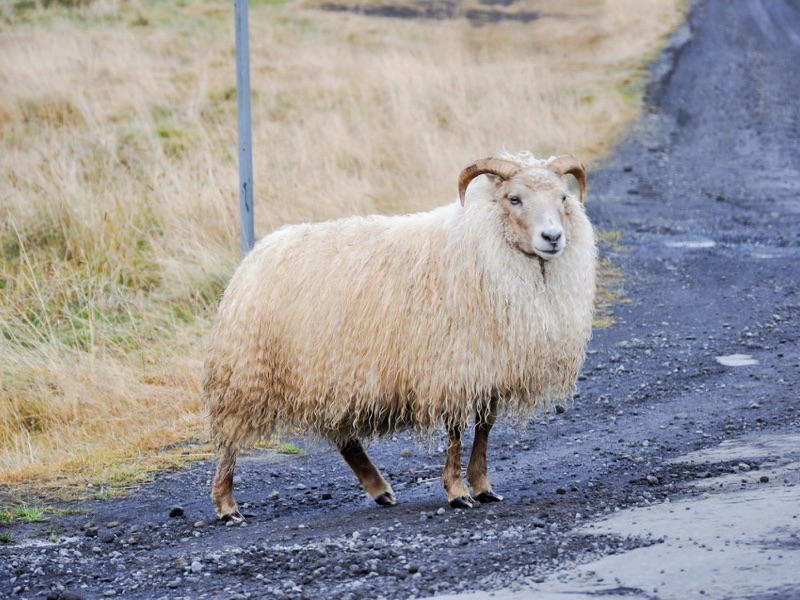Icelandic Wool
Variety: Icelandic wool
Fiber Origin: Icelandic Sheep
Provenance: Iceland
Characteristics:
- Composed of two fibres: Tog (outside) and Þel (inside).
- Tog: long, waterproof fibre.
- Þel: short, soft and thermally insulating fibre.
- Length of outer fibres: 6-8 cm.
- Length of inner fibres: 3-5 cm.
- Outer fibre diameter: 27-30 microns.
- Inner fibre diameter: 10-12 microns.
- Variety of natural colours: white, brown, grey, black.
- Durability and wear resistance.
- Excellent insulation properties.
- Moisture-repellent due to tog layer.
- Breathable and suitable for various weather conditions.
Icelandic wool is unique in its composition. It is composed of two distinct fibres: the outer fibre, Tog, which is water resistant and longer, and the inner fibre, Þel, which is shorter and softer, providing thermal insulation.
This dual structure gives it a number of properties that make it stand out from others, such as its ability to repel moisture and keep warmth even in humid conditions.
In addition, its variety of natural colours and its resistance to wear and tear make it particularly popular.
Despite its ability to retain heat, it is breathable, adapting to different climatic conditions.
Icelandic wool is famous for its exceptional quality and incredible warmth. This type of wool comes from sheep that roam freely in the vast landscapes of Iceland, enduring adverse weather conditions and adapting to their environment.
The result is a strong, durable fibre that has kept Icelanders warm for centuries.
HISTORY OF ICELANDIC WOOL
The history of Icelandic wool is also a reflection of the history of Iceland, a resilient sheep capable of adapting to the harshest climatic changes as well as the Icelandic people.
Early beginnings:
The history of Icelandic wool begins with the arrival of the Norse settlers in the late 9th century. These early Vikings brought with them hardy sheep, which over time, evolved into other breeds that due to their lack of contact with other races have made it very unique.
Medieval prosperity:
By the medieval period, wool had become one of the cornerstones of the Icelandic economy. The islanders depended on it not only for clothing but also for trade. Wool was processed into textiles such as home weaving (a type of woven cloth) which was then exported, becoming an important source of income for the island.
Survival and Self-Sufficiency:
Iceland's harsh climatic conditions made self-sufficiency crucial for the inhabitants. The characteristics of this wool provided essential protection against cold, wet and windy conditions. The wool was used to make everything from clothing to sails for ships.
Modern Renaissance
Although the importance of wool declined with industrialisation and easier access to imported products in the 20th century, there has recently been a resurgence in its value.
Today, Icelandic wool is prized for its quality, sustainability and heritage. Fashion designers and artisans are rediscovering and championing its unique properties, fusing tradition with contemporary fashion.
Cultural significance
Beyond its practical uses, Icelandic wool has a special place in the country's cultural and historical identity. The traditional patterns and weaving techniques passed down from generation to generation are a testament to the enduring relationship between the Icelandic people and their sheep.
CHARACTERISTICS OF ICELANDIC WOOL
- Double fibre structure: Icelandic wool is composed of two types of fibres:
- Tog: The outer fibre, which is long, coarse and water-resistant.
- Þel: The inner fibre, which is soft, fine and highly insulating.
- Length and diameter:
- Tog: These outer fibres have a length of 6 to 8 cm and a diameter ranging from 27 to 30 microns.
- Þel: The inner fibres are shorter, usually between 3 and 5 cm, with a diameter of 10 to 12 microns.
- Natural colours: Icelandic wool comes in a variety of natural shades such as white, brown, grey and black.
- Thermal properties: Thanks to its double-fibre structure, Icelandic wool offers excellent insulation. It retains warmth even when wet, making it ideal for Iceland's fluctuating and often harsh climate.
- Water resistance: The tog layer of the wool provides a water-resistant barrier.
- Breathability: Despite its warmth, Icelandic wool is also breathable, making it suitable for a wide range of temperatures and conditions.
- Durability: Icelandic wool is known for its durability and wear resistance, which ensures the longevity of garments and fabrics made from it.
- Natural elasticity: Icelandic wool has a natural elasticity, which means that garments made from it retain their shape well, providing comfort and a good fit.
- Sustainability: Icelandic sheep are raised naturally and sustainably, grazing freely in the wild landscapes of Iceland. This makes Icelandic wool a sustainable and environmentally friendly material.
In essence, Icelandic wool is not just a material; it is a blend of nature, history and craftsmanship. Its benefits go beyond mere functionality, offering warmth, style and a touch of Icelandic tradition.
Uses
Icelandic wool, with its unique properties, has been used in a variety of ways over the centuries. Here are some of the main uses of this versatile material:
- Knitwear: Sweaters (Lopapeysa), scarves and shawls, hats and mittens.
- Blankets;
- Carpets and rugs;
- Yarns: Icelandic wool is spun into yarns of different thicknesses, which are then used by weavers and craftsmen all over the world;
- Upholstery;
- Felt: such as slippers, bags and artistic creations.
- Insulation: sometimes used as an insulating material.
- Footwear: inner linings of footwear.
- Artistic endeavours: creative projects, from tapestries to sculptures.
Conclusion
In conclusion, Icelandic wool is a unique and valuable material that has been cherished by the Icelandic people for centuries. Its exceptional quality and warmth make it ideal for creating durable and insulating garments.
The traditional methods used to produce Icelandic wool ensure that its natural properties are preserved, making it an environmentally friendly choice.



Users Reviews